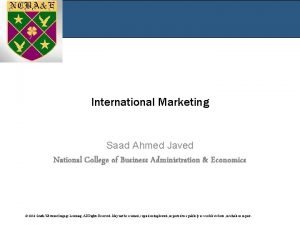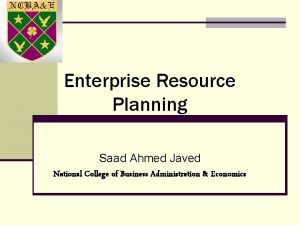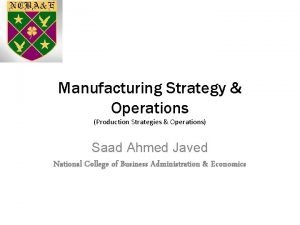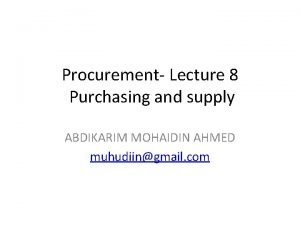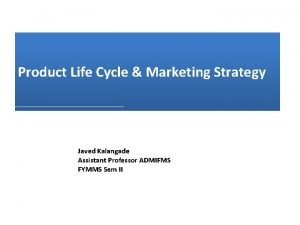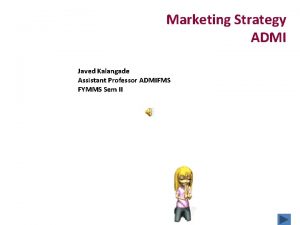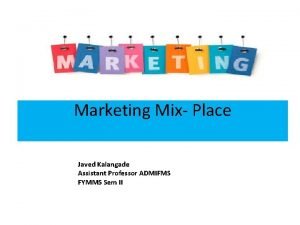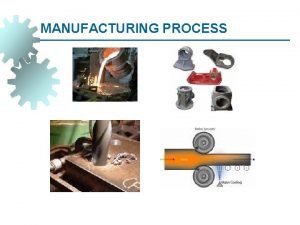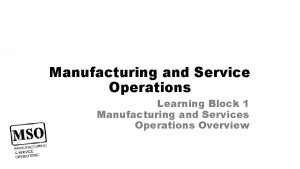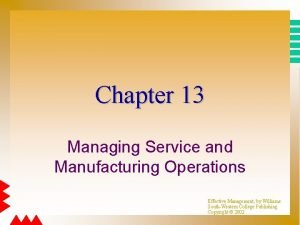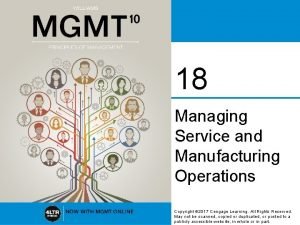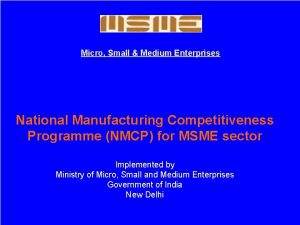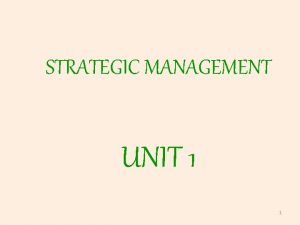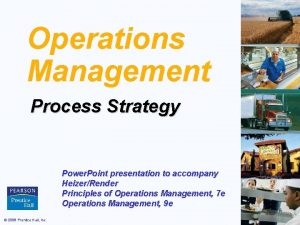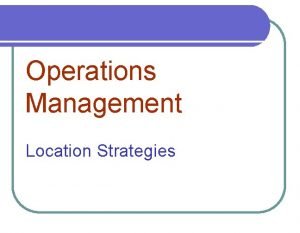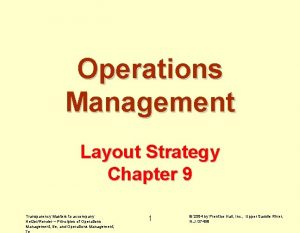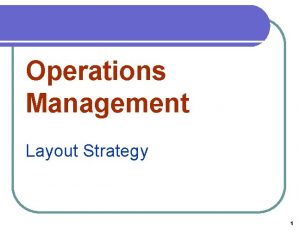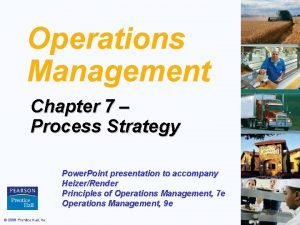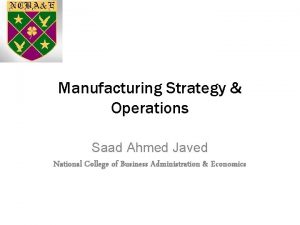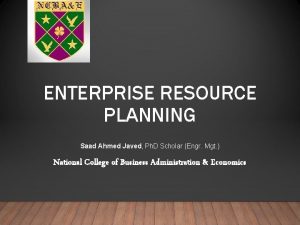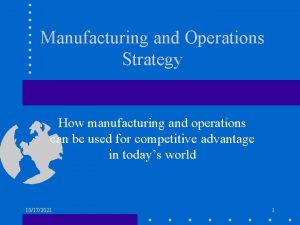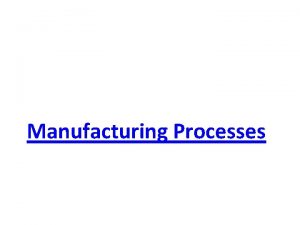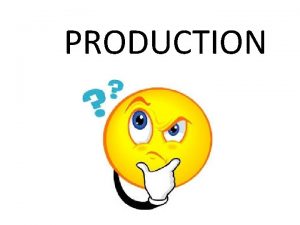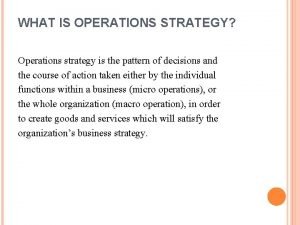Manufacturing Strategy Operations Saad Ahmed Javed National College








































- Slides: 40

Manufacturing Strategy & Operations Saad Ahmed Javed National College of Business Administration & Economics

Levels of Strategy & Manufacturing Operations Ch. 4 2

Levels of Strategy Diagram adapted from Restoring Our Competitive Edge by R. H. Hayes & S. C. Wheelwright and from 3 “Manufacturing Strategic Planning” by D. A. Garvin.

Cartoon 4

Typical Views of Manufacturing In some companies, many managers believe that there is no such thing as a Manufacturing Strategy. The quotes on the next slide illustrate the belief that Manufacturing exists to do whatever it takes to satisfy R&D and Marketing/Sales. 5

Typical Views of Manufacturing (continued) “R&D designs the product, Marketing/Sales sells the product, and then Manufacturing produces what it’s told when it’s told. ” “Manufacturing is supposed to make up R&D delays and change orders and meet whatever promises are made by Marketing/Sales. ” “In our top management meetings, R&D and Marketing/Sales dominate the discussion and, at the end of the meeting, Manufacturing is told what to do. ” “Everything is going well in Manufacturing when you don’t hear any complaints about it. ” 6

Typical Views of Manufacturing (continued) In this session, my goals are: To convince you that the quotes on the previous slide are wrong and that there is such a thing as a Manufacturing Strategy. To provide you with a broad framework for thinking about a Manufacturing Strategy. During the remainder of our sessions, we will see both good and bad elements of a Manufacturing Strategy. 7

Reason #1 Why “Chipping Away” at Productivity Doesn’t Work “Chipping away” at Productivity does NOT work because: 1. It is concerned mostly with the efficiency of direct labor, which is a low percentage of total costs. In contrast to Direct Costs, Indirect Costs are costs associated with activities such as process engineering, software development, quality control, and maintenance. Direct Labor Costs as a percentage of Total Costs: 8

Reason #2 Why “Chipping Away” at Productivity Doesn’t Work “Chipping away” at Productivity does NOT work because: 2. It focuses excessively on improving workers’ efficiency. Studies have shown that improvements that lower costs can be categorized as follows: 40% Manufacturing Structure (e. g. , the number, size, location, & capacity of facilities) and Materials Management 40% Equipment and Process Technology 20% Conventional Productivity Improvement There is a higher “payoff” to focusing on the two 40% categories. 9

Reason #3 Why “Chipping Away” at Productivity Doesn’t Work “Chipping away” at Productivity does NOT work because: 3. It fails to support any other business strategy than being a “low-cost” provider. As we will see later in this session, sometimes the business strategy should place less priority on Cost and more priority on Quality, Flexibility or Dependability/Trustworthiness. Examples: Mercedes and Ritz-Carlton. 10

Corporate Culture 11

Corporate Culture (continued) Corporate Culture is the set of guiding principles, driving forces, and engrained attitudes that help communicate to all employees at all levels of the organization goals, plans, policies, and what is right and wrong. Corporate Culture is reinforced through conscious behavior and unconscious behavior. Signs Mission Statement Dress Interaction Between Management and Labor 12

Corporate Culture at Southwest Airlines At Southwest, there is a Culture Committee with 100+ members to reinforce the culture by: Planning celebrations. Ensuring that new employees understand the airline’s “underdog” origins. Passing on to all employees extraordinary customer service by an employee that captures the “spirit” of Southwest. 13

Definition of Strategy Webster’s Dictionary defines “strategy” as follows: “… the science and art of military command used to meet the enemy in combat under advantageous conditions. ” business management “… the science and art of ^ military command competitor in competition used to meet the ^ enemy in combat under advantageous conditions. ” 14

Corporate Strategy 15

Corporate Strategy (continued) The Corporate Strategy: 1. Specifies the businesses in which the corporation will compete – that is, the number and type of business units and, for each business unit, the geographic and demographic markets in which the business unit will compete. Toyota has Toyota and Lexus. Marriott has Marriott Hotels, Courtyard by Marriott, & Fairfield Inn. Gap has Banana Republic, The Gap, & Old Navy. 2. Acquires important corporate resources ($$$ and personnel) and then allocates these resources across the business units. 16

Business Strategy The Business Strategy specifies the priorities with which the business unit will achieve and maintain its competitive advantage. 17

The Four Major Categories of Competitive Priorities for a Business Strategy A customer buys a product or service because of his/her perception of Cost Quality Delivery Flexibility 18

Cost and its Subcategories Cost • Initial Cost (purchase cost of an auto) • Operating Cost (gasoline cost per mile) • Maintenance Cost (cost of a tune-up) 19

Quality and its Subcategories Quality • Performance (primary characteristics; e. g. , picture clarity for a TV) • Features (secondary characteristics; e. g. , remote control for a TV) • Reliability (frequency that repair is needed) • Conformance (to pre-specified standards) • Durability (time until replacement is needed instead of repair) • Serviceability (speed, courtesy, competence) • Aesthetics (look, feel, smell) • Perceived Quality (brand image; e. g. , for Mercedes or Rolex) 20

Delivery and its Subcategories Delivery • Accuracy/Completeness (correct items in correct quantities) • Dependability (on-time delivery) • Availability (in-stock) • Speed (lead time; i. e. , elapsed time from placement of order until its receipt) • Information Availability (use Internet for real-time order status) • Quality after Shipment (breakage) • Ease of Ordering (ability to order over Internet) • Shipment Flexibility (ability to expedite a shipment) • Ease of Return • Customer Support 21

Flexibility and its Subcategories Flexibility • Product Flexibility (features, innovation, and ability to customize) • Volume Flexibility (response to unanticipated demand) • Process Flexibility (adapt process to provide a variety of products) 22

Remarks about Competitive Priorities for a Business Strategy 1. Within the same corporation, different business units will probably have different business strategies. 2. For a business unit, it is difficult and perhaps even dangerous to emphasize all four of C, Q, D, & F. It is best to focus on at most two of C, Q, D, & F. 3. Once a business unit chooses a competitive priority, then it is difficult and perhaps even dangerous to emphasize all subcategories within the priority. 4. A business unit’s management must quickly recognize when an internal decision (e. g. , introduction of a new product) or an external factor (e. g. , a new competitor) requires a change in the business strategy. 23

The Business Strategy Depends on the Position in the Product-Process Matrix 24

25

26

Job Production • Job production, sometimes called jobbing or one-off production, involves producing custom work, such as a one-off product for a specific customer or a small batch of work in quantities usually less than those of mass-market products. • Examples: Tailor, Jeweler, Customized Bakery, Restaurants, House Builders etc 27

Batch Production • Batch production is a technique used in manufacturing, in which the object in question is created stage by stage over a series of workstations, and different batches of products are made. • Example: Commercial Bakeries, Sports shoes manufacturers, Pharmaceutical companies etc 28

Line Production • Line Production or Assembly Line Process or Repetitive manufacturing process in which each product passes through the same sequence of operations, and the machines and other equipment are laid-out in the order they are used. Line production is dedicated to the needs of a single or small group of products and (unlike in batch production) the process does not have to be stopped and restarted for each new product. • Example: Assembly line of Automobile company or Branded Cloths manufacturers. 29

Continuous Production • Continuous production is a flow production method used to manufacture, produce, or process materials without interruption. Continuous production is called a continuous process or a continuous flow process because the materials, either dry bulk or fluids that are being processed are continuously in motion, undergoing chemical reactions or subject to mechanical or heat treatment. • Example: Flour mills, Sugar mills, petroleum industries, Fertilizers manufacturers etc 30

Functional Strategies 31

Functional Strategies Vertical & Horizontal Coordination Vertical Coordination Horizontal Coordination Which is harder – Vertical Coordination or Horizontal Coordination? 32

Vertical Coordination • Management of the Business Unit must clearly communicate the business strategy to the managers of Functional Areas. • Vertically structured, or "tall" companies have a chain of management, usually with a CEO at the top making decisions and then delegating authority to lower-level managers. 33

Horizontal Coordination • Through a specific and consistent pattern of decisions, all functional strategies must support the competitive priorities of the business strategy. • Horizontal, also called “flat”, companies have almost no middle managers – meaning that high-level managers handle day-to-day tasks and usually interact with customers and frontline employees personally. 34

A “Nightmare” of Functional Strategies Management of the Business Unit never communicates the business strategy to the managers of the Functional Areas and is ignorant of the fact that R&D thinks that the competitive priority is Flexibility and thinks that it can demand as many change orders as it wants. Manufacturing thinks that the competitive priority is Cost and bases all its decisions on what is the cheapest thing to do. Marketing/Sales thinks that the competitive priority is Dependability and feels it can promise delivery as soon as a customer wants its. 35

Manufacturing Strategy 36

Manufacturing Strategy (continued) The purpose of the Manufacturing Strategy is to: Support the Business Strategy. Complement the other Functional Strategies. For example, in many companies, there is frequently a tension between R&D and Manufacturing. R&D views itself as a collection of creative people with the role of designing the most innovative product possible, even if it means submitting to Manufacturing a continual stream of change-orders. On the other hand, Manufacturing views itself as a collection of practical people with the role of minimizing the manufacturing cost per unit. Who is right – R&D or Manufacturing? 37

Manufacturing Strategy Two Types of Decisions 38

References Restoring Our Competitive Edge, Robert H. Hayes and Steven C. Wheelwright, John Wiley & Sons, New York, 1984. “The Productivity Paradox”, Wickham Skinner, Harvard Business Review, July-August 1986, pp 5559. “Competing on the Eight Dimensions of Quality”, David A. Garvin, Harvard Business Review, Nov. -Dec. 1987, pp 101 -109. “Manufacturing Strategic Planning”, David A. Garvin, California Management Review, Summer 1993, pp 39 85 -106.

Thank You 40
 Saad ahmed economics
Saad ahmed economics Saad ahmed javed
Saad ahmed javed Manufacturing strategies
Manufacturing strategies Avp 3
Avp 3 Ahmed muhudiin ahmed
Ahmed muhudiin ahmed Amenities and facilities difference
Amenities and facilities difference Ahmed bawany academy school & college
Ahmed bawany academy school & college Manufacturing cost vs non manufacturing cost
Manufacturing cost vs non manufacturing cost Process vs job costing
Process vs job costing Uncontrollable cost example
Uncontrollable cost example Manufacturing cost vs non manufacturing cost
Manufacturing cost vs non manufacturing cost Additive manufacturing vs subtractive manufacturing
Additive manufacturing vs subtractive manufacturing Javed kalangade
Javed kalangade Javed kalangade
Javed kalangade Javed kalangade
Javed kalangade Mazhar javed awan
Mazhar javed awan Characteristics of patriarchy
Characteristics of patriarchy Classification of production system
Classification of production system Difference between manufacturing and service operations
Difference between manufacturing and service operations Managing service and manufacturing operations
Managing service and manufacturing operations Managing service and manufacturing operations
Managing service and manufacturing operations Klodia saad
Klodia saad Dr sadia saad
Dr sadia saad Tidal energy assignment
Tidal energy assignment Saad ahmad md
Saad ahmad md Saad bashir
Saad bashir Télégestion saad
Télégestion saad Joanne saad
Joanne saad Mohsen hassan
Mohsen hassan Salman azhar
Salman azhar Dr hussein saad
Dr hussein saad Saad alshahrani
Saad alshahrani Polyvalor
Polyvalor National manufacturing competitiveness programme
National manufacturing competitiveness programme Strategic intent hierarchy
Strategic intent hierarchy Operation strategy in a global environment
Operation strategy in a global environment Process focus strategy
Process focus strategy Service location strategy
Service location strategy Layout strategy in operations management
Layout strategy in operations management Interdepartmental flow graph
Interdepartmental flow graph Process strategy operations management
Process strategy operations management
